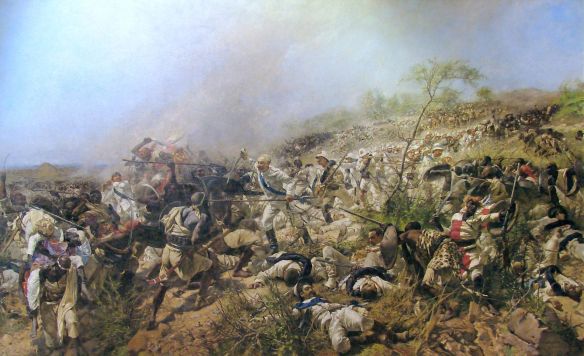The battle of Dogali by Michele Cammarano.
The Negus Negasti Menelik II and his high command, in an engraving made at about the time of the battle of Adowa. While these men wear lion’s-mane headdresses and elaborately embroidered silk robes, and carry decorated shields, note that they are armed with rifles. Before March 1896 the Italians often mistook Ethiopian adherence to tradition for an inability to embrace useful technologies.
The Emperor Yohannes IV of Ethiopia resented being cut off from the sea by this new Italian incursion. Tensions arose, especially in 1887, when the Italians decided to strengthen their position by pushing inland and taking over the villages of Ua-à and Zula. The local lord, Ras Alula, demanded that the Italians leave, and when they failed to do so he gathered 25,000 warriors. On 25 January 1887 he attacked the fort at Saati, held by 167 Italians and 1,000 native troops, but found it too strong to take. He had better luck the next day, when he attacked a relief column heading for the fort. Led by LtCol De Cristoforis, this force consisted of 500 Italians, 50 native irregulars, and two machine guns. Ras Alula ambushed them at Dogali with about 10,000 warriors; the Italian machine guns soon jammed, and the relief force was surrounded and cut 4 down. The Italians lost 23 officers and 407 men killed, one officer and 81 men wounded. The Italians estimated that Ras Alula lost 1,000 warriors at the battle of Dogali, although this is debatable. The Italians quickly vacated the contested villages, as well as the fort at Saati.
This defeat led to a massive Italian reinforcement of what would become their colony of Eritrea. By the end of 1887 troops in the colony numbered 18,000, of whom only 2,000 were natives, and an arms embargo on Ethiopia was in place. The military governor, Gen Di San Marzano, fortified Massawa, retook the inland villages and fort, and began building more forts on the border and at key internal sites. He also started building a railway from Massawa to Saati, to exploit the region’s mineral wealth.
By the end of March 1888, the Emperor Yohannes and Ras Alula were negotiating peace with the Italians. The colony continued to strengthen and expand, and in October 1888 the first units of ascari were formed. These native battalions were mostly drawn from the Eritrean population, along with Sudanese gunners, and they replaced the irregular Turkish and local mercenaries that the Italians had previously employed.
The Italians’ next challenge came from the loosely structured Mahdiyya army in the Sudan. The Mahdi claimed to be the new prophet of Islam, and his devout followers drawn from disparate peoples made great gains against the British-sponsored Egyptians and neighbouring tribes. There had been a longstanding rivalry between these Muslim warriors and the mostly Christian Ethiopians. Emperor Yohannes campaigned against the Dervishes, but, while at first successful, he was defeated and fatally wounded at the battle of Metemma on 9 March 1889. The Italians took advantage of Yohannes’ absence on campaign to push further inland, taking the Tigréan provinces of Hamacen, Okule-Kasai, and Serae; these would become the principal territories of the future colony, and modern nation, of Eritrea.
On his deathbed, Yohannes declared his nephew Ras Mangasha as his ‘natural son’ and successor, but Mangasha faced powerful rivals for the throne. The most prominent was Menelik of Shewa – the region surrounding the capital, Addis Ababa – who had stayed neutral in the struggle between Yohannes and the Italians in return for Italian guns. Ruling over the populous and fertile central part of the country, Menelik had tens of thousands of warriors at his command, and was already in secret negotiations with the Italians to consolidate his political position. When Yohannes named Ras Mangasha as his heir, Menelik proclaimed himself Negus Negasti on 26 March 1889. The Italians supported Menelik, and on 2 May 1889 the two parties signed the Treaty of Wuchale. This recognized Menelik II as emperor, while in return Menelik conceded most of the land that Italy had already occupied. The treaty also declared a permanent friendship between the two parties, and set up trade connections. However, one contentious clause guaranteed that this treaty would eventually fail. Article 17 stated, in the Italian version, that Italy would control Ethiopia’s external affairs; the Amharic version said that Menelik could choose whether or not to ask the Italians to act on his behalf, but was not required to do so. It is unclear why the wording was different; the Ethiopians said it was a trick, while the Italians blamed the Ethiopian translator.
Whoever was to blame, Article 17 soon caused trouble. When Menelik sent letters to England and Germany announcing his accession to the throne, he was told that since the Italians controlled Ethiopia’s foreign affairs these messages should have gone through them. He wrote in protest to King Umberto of Italy, and when he failed to get satisfaction he openly renounced the treaty in February 1893.
